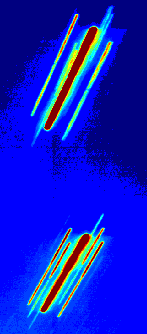DISPERSIVE
ANOMALOUS DIFFRACTION STUDIES OF MODULATED STRUCTURES
V.
Favre-Nicolin1, S. Bos1, E. Lorenzo1, J.-L. Hodeau1, W. Shepard2, T. Neisius3
1Laboratoire de
Cristallographie, CNRS BP166, 38042 GRENOBLE Cedex, FRANCE
2LURE, Bat. 209D, F-91045 ORSAY,
FRANCE
3ESRF, F-38043 GRENOBLE Cedex,
FRANCE
e-mail : favre@polycnrs-gre.fr
Keywords : anomalous
diffraction, dispersive diffraction, MAD, synchrotron radiation,
charge-density-wave, phase transitions.
X-ray experiments in the vicinity
of resonant edge of an atom shows an energy dependence of the
diffracted intensity, and the shape of intensity variations vs.
the energy changes drastically with the phase of the
structure factor. Biologists routinely use these variations to
solve structures with MAD [1] (Multiple Anomalous Diffraction).
This method can also be applied to solve complex inorganic
structures, such as modulated ones.
Application to
modulated structures
: modulated structures (for example in Charge-Density-Wave (CDW)
compounds) exhibit satellite reflections, which are a
highly selective source of information about the CDW ground
state. The measurement of both amplitude and phase for
these satellite reflections thus provides an unique tool to
determine the atomic displacements giving rise to the
modulated structure and to retrieve the electronic instabilities
at the origin of the CDW.
Dispersive
diffraction : when we
can measure only few reflections, it is important to obtain a
good precision on the determination of the phase : this can be
achieved if the whole I(E) spectrum around the absorption edge is
measured. We have developped a dispersive diffraction
setup [2] at the ESRF, which allows us to collect a whole I(E)
spectra on a continuous range (200-800 eV) around an absorption
edge, in a short oscillation scan [see fig. 1]. This enables us
to measure from 10 up to 30 reflections in a few minutes, using a
2D detector, thus allowing easier study of phase transitions. For
this new method, we have developped a software "DAD" to
calibrate, normalize and correct the raw intensities before
refinement.
| fig. 1
: dispersive diffraction images on (TaSe4)2I : (a) above Tc, with two Bragg
reflections. The line corresponds to the I(E) spectra,
with high energies at the bottom of the image and low
energies at the top. The minimum in intensity coresponds
to the absorption edge.
(b) below Tc, each Bragg
reflection is surrounded by 8 satellite reflections (4
strong and 4 weak). Each line gives information about
both amplitude and phase for the reflection.
|
  (a) room temperature (b) T=100K
|
Sample studied : the transition metal tetrachalcogenide
(TaSe4)2I is the focus of this study. This
compound crystallises with tetragonal symmetry and consists of
TaSe4 chains which
are parallel to the c-axis and separated by iodine atoms [3]. The
metal-metal distances along the chain are found to be equivalent
(3.2A) and their interaction
is only through dz2 overlap. Given the number of electrons per
metal site (0.5) and the symmetry considerations of the space
group of the crystal (I422), the wavevector of the atomic
modulation (2kF)
is at the centre of the Brillouin zone. X-ray studies have
indicated 8 incommensurate reflections appearing below the phase
transition temperature (TcA
265K) [4] at K=G+q where q=(±0.05, ±0.05,
±0.085), i.e., close to the Brillouin zone centre.
Further x-ray studies [5], based
on measurements of the integrated intensities of 6 satellite
reflections, have shown that the overall atomic displacements
pattern is acoustic like, with a strong component of the
displacements transverse to the chain axis. This result is at the
odd of our understanding of CDW transitions, where one expects
that antiphase metal atoms displacements along the chain
direction be the most important and at the origin of the CDW
state.
We will present results from
experiments made on (TaSe4)2I at the ESRF on ID24 beamline : we
collected diffraction lines [see fig.1] both above and below Tc,
for sublattice and satellite reflections. The recorded I(E)
spectra will be compared with refinement taking into account (i)
the acoustic model for the modulation from ref. [5] and (ii)
shifts of Ta atoms along c, corresponding to the expected Ta
tetramerization [6].
[1] W.A. Hendrickson , Science 254 (1991),
51,
[2] J-L. Hodeau et al., Rev. Sci. Inst. 66 (1995),
(2)
[3] P. Gressier, L. Guemas and A. Meerschaut, Acta Cryst.
B38 (1982), 2877
[4] H. Fujishita, M. Sato and S. Hoshino, Solid State Commun.
49 (1984), 313
[5] K.B. Lee, D. Davidov and A.J. Heeger, Solid State Commun.
54 (1985), 673
[6] J.E. Lorenzo, PhD. Thesis, University of Grenoble (1992) ;
J.E. Lorenzo, R. Currat, P. Monceau, B. Hennion and F. Levy,
Phys. Rev. B47 (1993), 10116